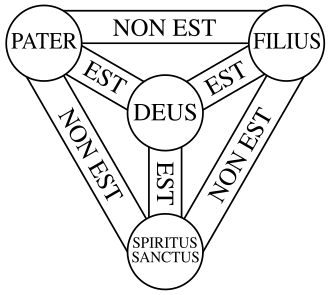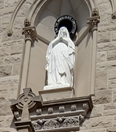Holy Trinity: Difference between revisions
Appearance
| (4 intermediate revisions by the same user not shown) | |||
| Line 22: | Line 22: | ||
** from hypo- (under) + ''stasis'' (standing or position) | ** from hypo- (under) + ''stasis'' (standing or position) | ||
* "'''hypostatic union''' | * ''hypostasis'' is singular for "Person" | ||
* ''hypostases'' is plural for "Persons" | |||
* | |||
=== '''hypostatic union''' === | |||
refers to the "union of the divine and human natures... of the Son of God, Jesus Christ" ([https://www.usccb.org/sites/default/files/flipbooks/catechism/884/ CCC Glossary]) | |||
* i.e. that Jesus Christ was fully human and fully divine | |||
=== Triune === | === Triune === | ||
| Line 37: | Line 44: | ||
"Now this is the Catholic faith: We worship one God in the Trinity and the Trinity in unity, without either confusing the persons or dividing the substance; for the person of the Father is one, the Son's is another, the Holy Spirit's another; but the Godhead of the Father, Son and Holy Spirit is one, their glory equal, their majesty coeternal" (Athanasian Creed: DS 75; ND 16). | "Now this is the Catholic faith: We worship one God in the Trinity and the Trinity in unity, without either confusing the persons or dividing the substance; for the person of the Father is one, the Son's is another, the Holy Spirit's another; but the Godhead of the Father, Son and Holy Spirit is one, their glory equal, their majesty coeternal" (Athanasian Creed: DS 75; ND 16). | ||
* See | * See | ||
** entry on [[Athanasian Creed]] | |||
** [https://www.ewtn.com/catholicism/teachings/athanasian-creed-209 The "Athanasian" Creed] (slightly different translation from EWTN) | ** [https://www.ewtn.com/catholicism/teachings/athanasian-creed-209 The "Athanasian" Creed] (slightly different translation from EWTN) | ||
== The Trinity == | == The Trinity == | ||
| Line 50: | Line 57: | ||
** Romans considered Christians atheistic, as they rejected Roman gods and refused to worship Caesar | ** Romans considered Christians atheistic, as they rejected Roman gods and refused to worship Caesar | ||
** gnostics and other heretics believed that Jesus fully God and not a Man, thus he was either not a man or not God | ** gnostics and other heretics believed that Jesus fully God and not a Man, thus he was either not a man or not God | ||
* St. Thomas Aquinas | |||
* | == Shield of the Trinity (''Scutum Fidei)'' == | ||
[[File:Shield-Trinity-Scutum-Fidei-compact.svg|left|thumb|Basic "Shield of the Trinity" diagram (wikipedia)]] | |||
[[File:Shield-Trinity-Scutum-Fidei-variations.svg|thumb|Four variants of the "Shield of the Trinity"]] | |||
* derived from the Athanasian Creed | |||
* God (DEUS) is at the center | |||
* the three Persons are at the corners | |||
* the shiled was consiered the "Herald of God" | |||
=== The forumulation of the Shield === | |||
* note that all the links (connections) are bi-directional (go both ways) | |||
* EST means "is" | |||
* NON EST means "is not" | |||
Thereby: | |||
* "The Father is God" | |||
* "The Son is God" | |||
* "The Holy Spirit is God" | |||
* "God is the Father" | |||
* "God is the Son" | |||
* "God is the Holy Spirit" | |||
* "The Father is not the Son" | |||
* "The Father is not the Holy Spirit" | |||
* "The Son is not the Father" | |||
* "The Son is not the Holy Spirit" | |||
* "The Holy Spirit is not the Father" | |||
* "The Holy Spirit is not the Son" | |||
== St. Thomas Aquinas on the Trinity == | |||
St. Thomas Aquinas thought deeply about the Trinity in ''Summa Theologica'' | |||
* his thought extends from the concepts of the Trinity and the Oneness of God: | |||
* One God | |||
* Two Processions | |||
*# The Father > The Son (Generation) | |||
*# The Father and The Son > Holy Spirit (Spiration) | |||
** Three Persons | |||
**# The Father | |||
**# The Son | |||
**# The Holy Spirit | |||
** Four Relations | |||
**# The Father > The Son = ''Paternity'' | |||
**# The Son < The Father = ''Filiation'' | |||
**# The Father and The Son > The Holy Spirit = ''Active Spiration'' (originiation) | |||
**# The Father and The Son < The Holy Spirit = ''Passive Spiration'' (procession) | |||
** Five Notions | |||
**# The Father > innascibility or unbegottennes | |||
**# The Father > paternity, i.e. The Father > The Son | |||
**# The Father and The Son "spirate" the Holy Spirit | |||
**# The Son = both Filiation and Spiration | |||
**# The Holy Spirit = Procession | |||
** notes: | |||
*** St. Thomas wrote in ''Summa Theologica'', | |||
**** ''"Although there are four relations in God, one of them, spiration, is not separated from the person of the Father and of the Son, but belongs to both;"'' | |||
*** these relations, originatinos, and processions are internal to God and not related to temporal process (outside of time) | |||
*** See: | |||
**** Univ Notre Dame: [https://www3.nd.edu/~afreddos/courses/417/trinityhandout.pdf trinityhandout.pdf] | |||
**** [https://catholicism.org/the-relations-in-the-blessed-trinity.html The 'Relations' in the Blessed Trinity - Catholicism.org] | |||
**** [https://prodigalcatholic.com/summary-of-chapter-23-trinitarian-relations-and-notional-names-of-persons-from-whites-book-the-trinity/ Summary of Chapter 23: Trinitarian Relations and Notional Names of Persons (from White’s book, The Trinity) – Prodigal Catholic] | |||
Latest revision as of 12:40, 16 December 2024
The "Trinity" or, "Holy Trinity" of the Father, the Son, and the Holy Spirit
- note: see glossary entry on "Holy"
The Holy Trinity is called collectively the "Godhead" or the "Triune"
- also, the "Blessed Trinity"
Terminology of the Trinity[edit | edit source]
Godhead[edit | edit source]
The Trinity may also be referred to as the "Godhead"
- = God in the full nature of the Trinity
- from Middle English God + hede (nature of)
- note: the Father is the "source and origin" of the Godhead, but the Godhead indivisibly consists of the Father, the Son and the Holy Spirit
- see CCC 2789
hypostasis[edit | edit source]
refers to the "Persons" of God; in Latin persona
- from Greek for "substance"
- from hypo- (under) + stasis (standing or position)
- hypostasis is singular for "Person"
- hypostases is plural for "Persons"
hypostatic union[edit | edit source]
refers to the "union of the divine and human natures... of the Son of God, Jesus Christ" (CCC Glossary)
- i.e. that Jesus Christ was fully human and fully divine
Triune[edit | edit source]
a similar reference to "Godhead" for the Holy Trinity
- but also used as an adjective, as in "the Triune God"
Athanasian Creed[edit | edit source]
or Quicunque vult
- an important early Church statement and explanation of the Holy Trinity
- from from CCC 266
"Now this is the Catholic faith: We worship one God in the Trinity and the Trinity in unity, without either confusing the persons or dividing the substance; for the person of the Father is one, the Son's is another, the Holy Spirit's another; but the Godhead of the Father, Son and Holy Spirit is one, their glory equal, their majesty coeternal" (Athanasian Creed: DS 75; ND 16).
- See
- entry on Athanasian Creed
- The "Athanasian" Creed (slightly different translation from EWTN)
The Trinity[edit | edit source]
The Holy Trinity is the mystery of God in three Persons: Father, Son, and Holy Spirit
- the Trinisy consists of the
- Persons of God: Father Son and Holy Spirit
- Natures of God: Creator, Redeemer, and Sanctifier
- the Trinity was source of much conflict and contention in the early Church
- and, ultimately, a core tenant of Church doctrine
- Jews were offended that fellow Jews worshiped Christ, as Judaism was supposed to be monotheistic
- Romans considered Christians atheistic, as they rejected Roman gods and refused to worship Caesar
- gnostics and other heretics believed that Jesus fully God and not a Man, thus he was either not a man or not God
Shield of the Trinity (Scutum Fidei)[edit | edit source]


- derived from the Athanasian Creed
- God (DEUS) is at the center
- the three Persons are at the corners
- the shiled was consiered the "Herald of God"
The forumulation of the Shield[edit | edit source]
- note that all the links (connections) are bi-directional (go both ways)
- EST means "is"
- NON EST means "is not"
Thereby:
- "The Father is God"
- "The Son is God"
- "The Holy Spirit is God"
- "God is the Father"
- "God is the Son"
- "God is the Holy Spirit"
- "The Father is not the Son"
- "The Father is not the Holy Spirit"
- "The Son is not the Father"
- "The Son is not the Holy Spirit"
- "The Holy Spirit is not the Father"
- "The Holy Spirit is not the Son"
St. Thomas Aquinas on the Trinity[edit | edit source]
St. Thomas Aquinas thought deeply about the Trinity in Summa Theologica
- his thought extends from the concepts of the Trinity and the Oneness of God:
- One God
- Two Processions
- The Father > The Son (Generation)
- The Father and The Son > Holy Spirit (Spiration)
- Three Persons
- The Father
- The Son
- The Holy Spirit
- Four Relations
- The Father > The Son = Paternity
- The Son < The Father = Filiation
- The Father and The Son > The Holy Spirit = Active Spiration (originiation)
- The Father and The Son < The Holy Spirit = Passive Spiration (procession)
- Five Notions
- The Father > innascibility or unbegottennes
- The Father > paternity, i.e. The Father > The Son
- The Father and The Son "spirate" the Holy Spirit
- The Son = both Filiation and Spiration
- The Holy Spirit = Procession
- notes:
- St. Thomas wrote in Summa Theologica,
- "Although there are four relations in God, one of them, spiration, is not separated from the person of the Father and of the Son, but belongs to both;"
- these relations, originatinos, and processions are internal to God and not related to temporal process (outside of time)
- See:
- St. Thomas wrote in Summa Theologica,
